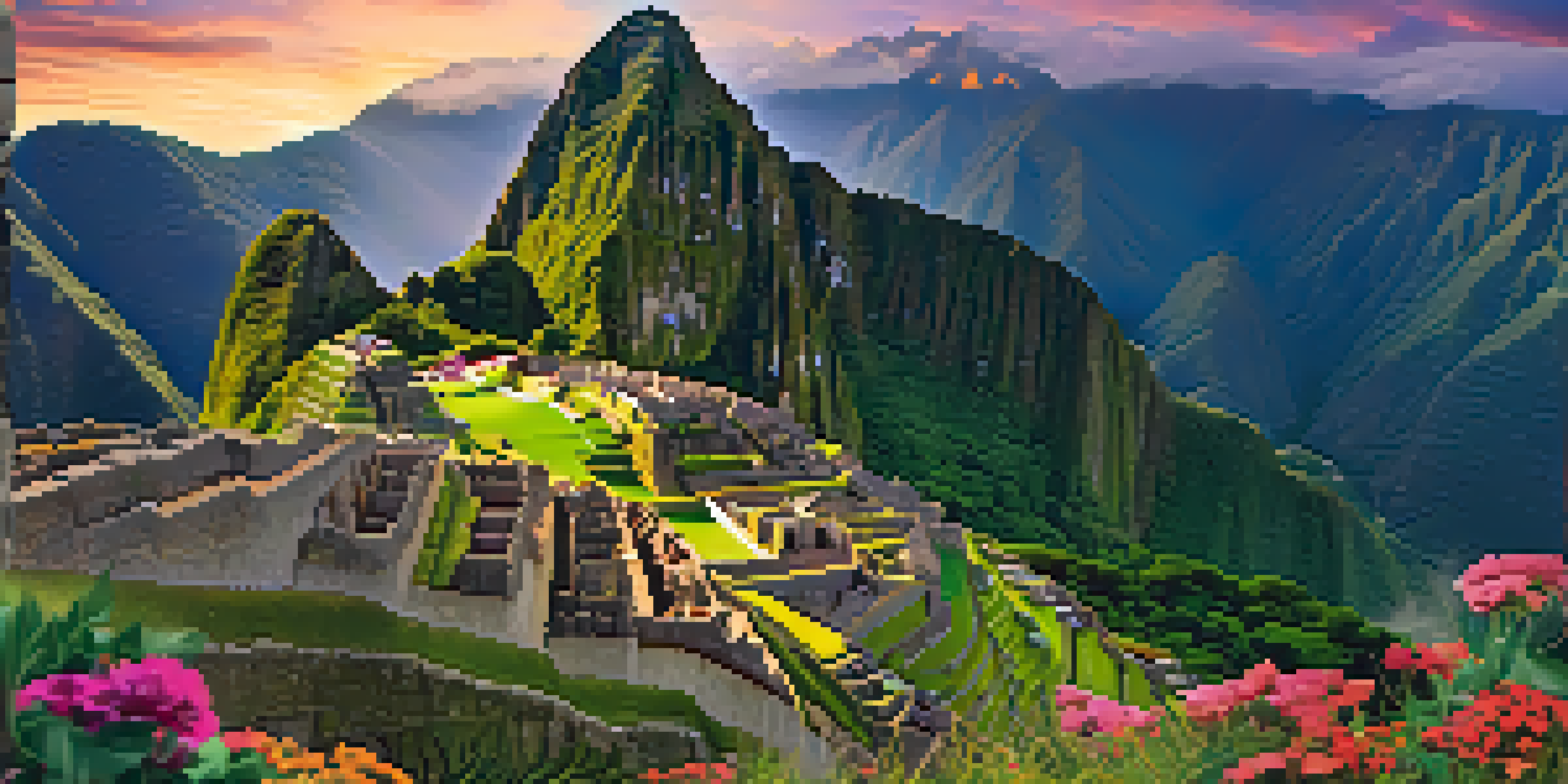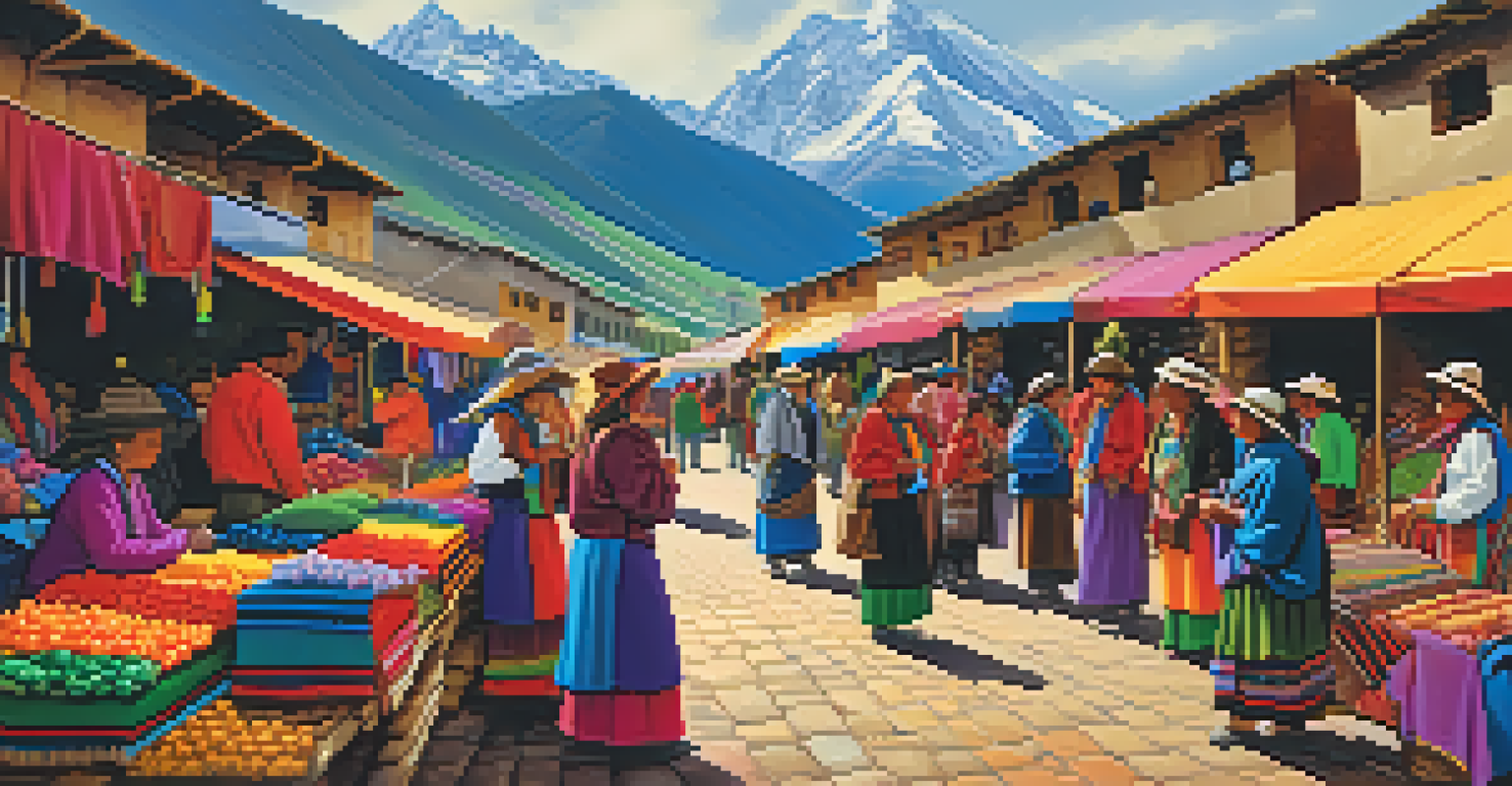Exploring the Rich History of Peru's UNESCO Heritage Sites

An Introduction to Peru's UNESCO Heritage Sites
Peru is home to an incredible array of UNESCO World Heritage Sites, each telling a unique story of its past. From ancient civilizations to colonial influences, these sites collectively showcase the rich cultural tapestry of the nation. The designation by UNESCO not only recognizes their significance but also helps to promote their preservation for future generations.
Preservation of our heritage is not a luxury; it is a necessity for future generations.
Among these remarkable sites, Machu Picchu often takes center stage, drawing millions of visitors each year. However, it’s essential to explore the lesser-known gems that contribute to Peru's rich historical narrative. Each site offers a glimpse into the lives of those who came before us, making them invaluable to understanding Peru's identity.
In this article, we will delve into some of the most significant UNESCO Heritage Sites in Peru, highlighting their historical importance and the stories they hold. Whether you're a history buff or a curious traveler, there's something to learn and appreciate about each of these treasures.
Machu Picchu: The Iconic Incan Citadel
Machu Picchu, often referred to as the 'Lost City of the Incas,' is perhaps the most famous of Peru's UNESCO sites. This 15th-century citadel is perched high in the Andes and showcases the architectural brilliance of the Inca civilization. Its intricate stonework and breathtaking views create an aura of mystery that continues to captivate visitors.

The site was rediscovered in 1911 by American historian Hiram Bingham, but its significance dates back to its construction as an estate for the Inca emperor Pachacuti. As you wander through its terraces and temples, you can almost hear the echoes of history reverberating through the stones. It's a testament to the ingenuity and artistry of the Incas, who harmonized their structures with the natural landscape.
Peru's Rich UNESCO Heritage
Peru is home to a diverse array of UNESCO World Heritage Sites that reflect its rich cultural and historical narrative.
Machu Picchu serves as a powerful reminder of the Inca Empire's vast reach and sophisticated society. It offers not just a visual feast but also an opportunity to contemplate the rich cultural heritage that continues to thrive in Peru today.
The Sacred Valley: A Cultural Heartland
Nestled between the Andean peaks, the Sacred Valley of the Incas is an area rich in history and culture. This UNESCO site encompasses several archaeological sites, traditional villages, and breathtaking landscapes, making it a vital part of Peru's heritage. It served as an important agricultural region and a sacred space for the Incas, who revered its natural beauty.
To travel is to discover that everyone is wrong about other countries.
Visitors can explore the ancient ruins of Pisac and Ollantaytambo, which provide insight into Incan agricultural practices and architectural prowess. The valley is also home to vibrant markets where local artisans showcase their crafts, allowing visitors to engage with the living culture of the descendants of the Incas. This blend of history and tradition makes the Sacred Valley a must-visit destination.
As you traverse the Sacred Valley, you can feel the spiritual connection the Incas had with their environment. It's a place where the past and present coexist harmoniously, inviting travelers to experience the richness of Peru's cultural heritage.
Nazca Lines: Ancient Geoglyphs of Mystery
The Nazca Lines, a UNESCO World Heritage Site, are one of the most mysterious and fascinating cultural landmarks in Peru. These massive geoglyphs etched into the desert floor depict various shapes, including animals and plants, and can only be fully appreciated from the air. Their origin remains a topic of intrigue, sparking countless theories about their purpose and the civilization that created them.
Dating back to between 500 BC and 500 AD, the lines are believed to have been made by the Nazca culture, although their exact significance is still debated. Some suggest that they were ritualistic pathways, while others believe they served as astronomical calendars. Standing before these colossal figures, one can’t help but marvel at the ingenuity of the ancient Nazca people.
Machu Picchu: A Cultural Icon
Machu Picchu stands as a testament to the ingenuity of the Inca civilization and continues to captivate visitors with its architectural brilliance.
Visiting the Nazca Lines is a journey into the unknown, where you can appreciate the artistic expression of a civilization long gone. It encourages visitors to ponder the mysteries of human creativity and the ways in which our ancestors engaged with their environment.
Cusco: The Historic Incan Capital
Cusco, once the capital of the Inca Empire, is a UNESCO World Heritage Site that boasts a rich and layered history. The city is a fascinating blend of Incan and colonial architecture, with its ancient stone walls standing alongside Spanish colonial buildings. Walking through Cusco feels like stepping back in time, as each corner reveals a story waiting to be told.
The Qorikancha, or Temple of the Sun, is a prime example of this fusion. Originally an Incan temple dedicated to Inti, the sun god, it was later transformed into the Santo Domingo Church by Spanish colonizers. This juxtaposition reflects the complex history of conquest and cultural exchange that has shaped Peru's identity over the centuries.
Exploring Cusco allows visitors to appreciate the resilience of the local culture, which has thrived despite the challenges of colonization. The city serves as a gateway to the Sacred Valley and Machu Picchu, making it a pivotal stop for anyone seeking to understand Peru's rich heritage.
Chan Chan: The Largest Adobe City
Chan Chan, the largest adobe city in the world, is another UNESCO Heritage Site that showcases the architectural prowess of the Chimu civilization. Located near Trujillo, this sprawling city was once the capital of the Chimu Kingdom and is a testament to their innovative use of adobe in construction. The intricate walls and elaborate designs speak volumes about the artistry and organization of this ancient society.
Constructed around the 9th century, Chan Chan is a complex network of walls, plazas, and temples, all crafted from mud bricks. Its layout is not only impressive but also functional, designed to manage the arid environment. Walking through its ruins, you can almost envision the bustling life that once filled its streets, with artisans, traders, and leaders going about their daily activities.
Preservation of Cultural Treasures
Protecting Peru's UNESCO sites is vital for maintaining their historical significance and ensuring that future generations can appreciate their legacy.
Visiting Chan Chan provides a unique opportunity to reflect on the daily lives of the Chimu people and their relationship with the environment. It stands as a reminder of the ingenuity of ancient civilizations and the importance of preserving their legacies.
The City of Arequipa: A Blend of Cultures
Arequipa, known as the 'White City' due to its stunning sillar stone architecture, is not only beautiful but also rich in history. This UNESCO World Heritage Site features a unique blend of colonial and indigenous influences, evident in its remarkable buildings and vibrant cultural scene. The city’s Plaza de Armas is a perfect example, surrounded by stunning baroque architecture and the backdrop of the Misti volcano.
The Santa Catalina Monastery, another highlight, is a city within a city, showcasing the religious and social life of the region during colonial times. Its vibrant colors and intricate designs invite visitors to explore its many nooks and crannies. As you wander through its halls, you get a sense of the deep spirituality that permeates Arequipa's history.

Arequipa's cultural richness is complemented by its culinary scene, where you can savor traditional dishes that reflect the region's history. Visiting Arequipa is a journey through time, offering a unique perspective on how different cultures have shaped Peru's identity.
Conclusion: The Importance of Preservation
As we explore Peru's UNESCO Heritage Sites, it's clear that preserving these treasures is crucial for future generations. Each site holds a wealth of knowledge about the past, offering insights into the civilizations that shaped the region. By visiting and supporting these sites, we contribute to their preservation and the ongoing story of Peru.
The efforts to protect these cultural landmarks are vital in maintaining their integrity against the pressures of modern development and tourism. Organizations and local communities work tirelessly to ensure that these sites remain accessible and vibrant, fostering a deeper appreciation for their historical significance.
Peru's Rich Cultural Heritage
Peru's UNESCO Heritage Sites showcase a diverse historical narrative, reflecting the influences of ancient civilizations and colonialism.
In conclusion, the rich history of Peru's UNESCO Heritage Sites invites us all to engage with the past while looking toward a sustainable future. By honoring these legacies, we enrich our understanding of humanity and the diverse cultures that have shaped our world.